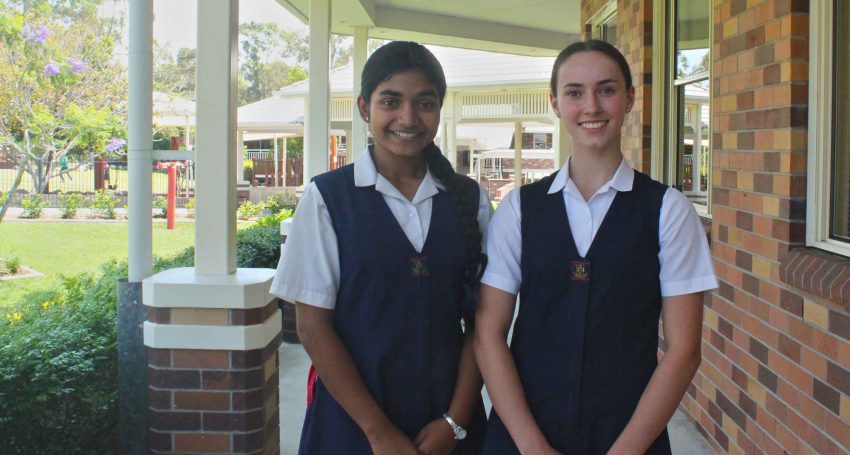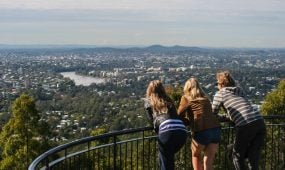Building a world where every child is in school and safe
Features
Two St Hilda’s students, Atputha Rahavan and Remi Long, share their thoughts on the focus of this year’s Universal Children’s Day to help build a world where every child is in school and safe – find out what Atputha and Remi have to say and download the official UNICEF resource kit

United Nations Universal Children’s Day was established in 1954 and is celebrated on 20 November annually to promote international togetherness and awareness of children worldwide, and to improve children’s welfare. 20 November is an important date as it is the date in 1959 when the UN General Assembly adopted the Declaration of the Rights of the Child. It is also the date in 1989 when the UN General Assembly adopted the Convention on the Rights of the Child. This year’s Universal Children’s Day focuses on the right of children to an education and to be safe at school, with the theme of #GoBlue.
Thank you to St Hilda’s School students Atputha Rahavan and Remi Long for sharing their thoughts on this year’s Universal Children’s Day theme.
The value of education – Atputha Rahavan, St Hilda’s School Year 10 student
In school we are exposed to many wonderful things that are at times taken for granted. Firstly, the subjects: Maths, English, Science, History. The list goes on. Then there are sports, clubs, orchestras and bands. However, the most important part of school is that fact that students are allowed to express their curiosity and learn freely.
In Australia, it is compulsory that all children start school by age six and continue until the age of 16 years. This law ensures that children are given an equal education and are allowed to explore and take part in many subjects that will prepare them for their future.
Advertisement
This mandatory learning time ensures that children are prepared fully for their future. School teaches students basic skills like writing, reading or even simple maths. Not only that, the school environment is one in which students are encouraged to make friends, engage with one another and learn to make connections. In school, students learn to be independent (all those assignments are worth something after all), learn to ask for help and how to help others. All these factors contribute to the foundation of how a child will grow throughout their lives. Education helps students acquire new skills and knowledge that will impact personal development in emotional, intellectual and, in future, economical aspects.
Education is a precious thing that is valuable to students because it allows them to create their own future. However, it must be taken into account that millions of children around the globe are not given the same chances to freely pursue an education. According to a report by global anti-poverty organisation, UNESCO, 20 percent of young people in developing countries fail to complete primary school and lack skills for work. The report found that in developing countries, there are still 250 million children of primary school age who cannot read or write, and 71 million teenagers who are out of secondary school and missing out on vital skills for future employment. This lack of education results in terrible consequences throughout young people’s lives as they miss out on opportunities for jobs. There is also the problem of a lack of education for young women and girls due to negative gender stereotypes. Of the 123 million young people between the ages of 15 and 24 who cannot read or write, 61 percent of them are female.
Education and school – these are two of the most priceless things in life. Education allows young people to choose and create a hopeful future not only for themselves, but for others as well. When you look at all the children, the girls and boys, who are denied this golden chance to learn, it really puts into perspective the value of education.
Safe learning spaces – Remi Long, St Hilda’s School Year 9 student
To learn, children and adolescents need to feel safe and supported. Given this, the importance of a safe learning environments for learners is something that cannot be overstated. When it comes to a student’s education, a safe and inviting space to work in is essential. While it is true that every student learns slightly differently from the next, the environment itself plays a significant role in their development. Safe learning spaces translate into comfortable learning spaces. They are places where learners can feel at home. Whether it be an open plan classroom or a sports oval; having spaces in which a student feels comfortable and welcomed is crucial in ensuring both the academic growth and mental health of the learner.
Advertisement
Furthermore, keeping schools safe also allows children to look forward to being in an encouraging environment that promotes social and creative learning. Without this, they are unable to focus on learning the skills needed for a successful education and future.
Evidently, creating a healthy classroom can have a positive impact on student learning as eloquently summarised by early childhood education expert Prof Pamela Evanshen, “Children in a teacher’s care deserve an environment that not only is supportive of their learning, but also is well-maintained, safe and meets both their physical and psychological needs.”
Download the official Universal Children’s Day campaign activities and resources, ‘World’s largest lesson school activity packs’, from the UNICEF website.





